

About every two months I present 3-hour courses in front of up to 60 people at a time, about RF: what it is, how it is handled, and RF safety in the laboratory. I use a lot of practical demonstrations because it is easier to teach when people see stuff done in practice. One demonstration is to show that any bit of wire can be an antenna, and I test a length of LAN cable using my Grid Dip Oscillator (GDO). My main problem is that my GDO-1 project, published on my homepages, was built about 35 years ago. The meter is small, and to be honest, it is functional but looks really, really old. The coils are starting to become deformed, the formers broken and when I project the instrument, using my DV-camera, on a 6-meter wide screen it really looks crappy and amateurish. So I decided that it is about time to build another GDO MKII, but I added a few features. The new features I wanted are:
The larger meter is required so I can project it on the 6-metre wide screen for all to see the dip. I want a power indicator, because it looks more pretty with a glowing RED lamp. People like to see an LED - looks technical. Another point is that this 65-year old brain keeps forgetting to switch the damn thing OFF after courses - I am sure that my brain has a mind of its own. Batteries normally lasted more than five years in the old GDO-1, but I have changed the battery three times during 2016 after leaving it switched ON. I have now decided that I will use two 12v photographic batteries, so if one fails then I can always use the other. It also needs to be mounted in a nice box, and with more robust (and posh-looking) coils.

The new GDO-2 circuit is almost identical to the old GDO-1 circuit, but I have used slightly different component values in the measuring circuit to drive a slightly less sensitive meter. The LED is added in series with the metering resistance, so it does not draw any extra current for the meter, in fact the LED has a 1.8v drop, which reduces the current the complete project draws. The complete project only draws 3.5mA, but it still gives a really strong deflection on the 100μA meter. Projected battery life is about 100 hours per battery. I am sure it will be quite useable if you only had a 500μA meter.
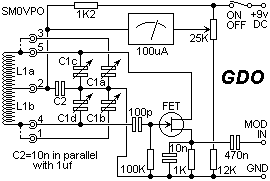 --------
--------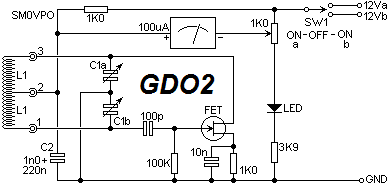
The old GDO-1 used a four-gang variable capacitor from a $5 VHF/AM radio, but this is not needed here. This uses the tuning capacitor from a $2 AM-only radio, but I bought the capacitor new from China. This project is only needed up to 200MHz, and the 200pf + 200pf (effective 12pf to 100pf) is good enough for up to 200MHz. I also used a single-pole on-off-on switch for the power, so that I could select either of the two 12v batteries.
The oscillator circuit is based on the BC256B N-Channel RF Field-Effect transistor (FET) amplifier. It is run at about 1mA, but this does vary a bit with frequency and the strength of oscillation. The oscillator acts as a 9000 Ω resistor, in series with a 1000 Ω resistor. This gives a voltage divider. A second voltage divider consists of a 1000 Ω potentiometer and a 3900 Ω resistor (in series with an LED). The meter movement is connected between the two voltage dividers to form a Wheatstone bridge, where the meter is deflected by the current caused by the voltage difference between the two voltage dividers.
Naturally, you could add a modulation input as yet another, additional feature, and I think I may well do this as some of the "finishing touches" to this project. This oscillator will give both AM and FM if you capacitively feed a signal into the source of the transistor. The meter balance pot also gives a very fine frequency adjustment if you are using a ´narow-band receiver to detect the oscillator. I have a few more toggle-switches, so I could add an internal microphone and an external modulation input. It would make a good wireless microphone for 88MHz to 108MHz FM band. You could even add my 222 stereo encoder and make a meal of it, but reduce the 10nf source by-pass capacitor to 1nf. The possibilities are limited only by your imagination ☺. Here are a few suggestions to get you started, but the 9th suggestion is probably the most useful idea:
The coil is tapped at 50%, which is often considered a disadvantage by many constructors, but for me this is not a problem. It allows me to re-use the same coils in other projects, such as a simple signal generator, and a regenerative receiver. I want to do some experiments with Tunnel Diodes and Lambda Diodes, so a ready stock of "standard" RF coils is a benefit for me.

The meter was robbed from an old Hi-Fi cassette recorder that I stole from the Märsta city dump. The meter fills the whole width of the 105 x 62 x 26 plastic project case. Yes, the new project uses a case that is smaller than the previous GDO project and it will even fit in my shirt pocket (if I remove the coil).
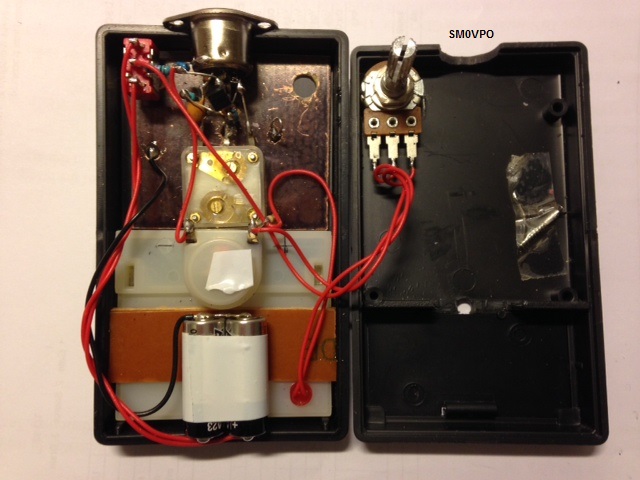
I bought the variable capacitor from China for about US$2, but I had to buy a pack of 10 of them. You can still buy those cheap'n-nasty AM transistor radios from China, and I even found a few radios in Chinese "Bazaar" shops in Spain. If you have the possibility to let me have a few new P-Channel FETs (similar in performance to BF256A) then I will send you a 4-gang capacitor VHF/UHF tuning capacitor. Please check with me by e-mail before sending. Unfortunately they came without the 2.5mm machine-screws.
Due to hand-capacitance and such you really need to have a metal ground-plane for the oscillator and the frequency-sensitive components. I took a piece of copper-clad board for making PCBs and cut it to fit into the available space in the plastic box, after the big-chunky meter was fitted. The ground-plane was sprayed with photo-resist, which prevents copper oxidation.
The PCB is held in place after being drilled to take the machine screws to mount the variable capacitor. I used longer M2.5 bolts to hold the capacitor because it also sandwiches the box front plate. Note that the bolts must be so cut that they do NOT go into the capacitor more than about 1.5mm, or they will foul on the brass tuning vanes inside the capacitor.
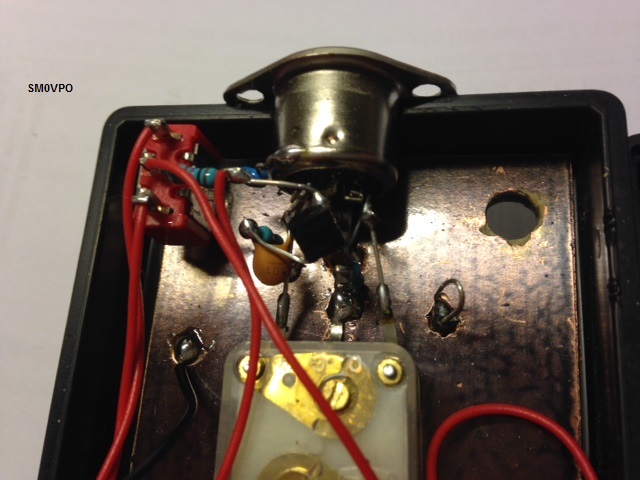
The coil socket is a simple 5-pin DIN, but I only used three pins. The coil socket hole in the case was drilled and filed to fit the socket but I did not have the space to use the mounting bolts, so the chassis tag was soldered to the copper board and the chassis was superglued to the case top. When the case is put together it is surprisingly stable and robust.
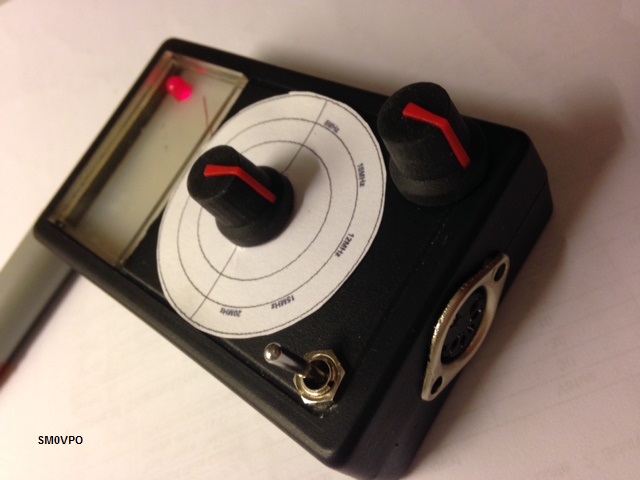
The coils are wound using 0.25mm Dia. enamelled copper wire. The coil former are all 15mm Diameter and are the little plastic tubes for the thermal printer paper, they throw them away from the supermarket checkout till machine. So you can ask your local Wallmart, Morrisons, Lidl, ICA or Asda supermarket to save them for you. You just need to do as I did, "chat-up" the girl behind the counter (but not when the wife is there).
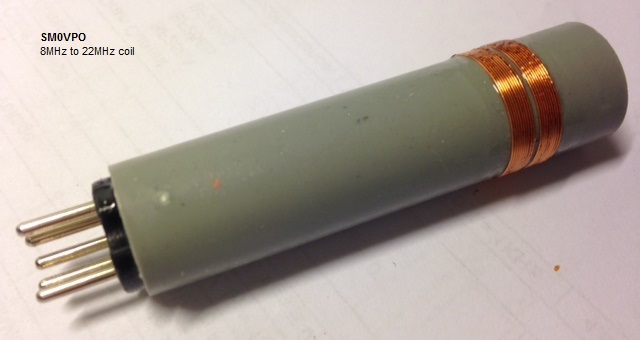
The first coil (above) covers 7.8MHz to 22.1MHz. The coil winding is 15mm Dia., 20 truns (10 + 10) of 0.25mm Dia. enamelled wire, close-wound, with 45mm jumper leads to the socket. The ambient room temperature was 21°C and the relative humidity was nearly 55%. I applied about 300 grams of winding force, and the coil was lightly smothered in super-glue, wiped off with a dry cloth, and I un-glued my finger and thumb using isopropyl alcohol.
You may want to compare this with the earlier GDO-1 project, where you will find the coil-winding data for all the other coils. If using the 15mm Dia formers I suggest for GDO-2 then the new frequencies will be about half those in the GDO-1 coil-winding table due to the larger coil diameter; about 60% of the frequency.
| Frequency span | Number of turns | Former Dia. | Winding length | Wire diameter |
|---|---|---|---|---|
| 1.7 MHz to 4.5 MHz | 160 turns (80 + 80) | 15 mm | 45 mm | 0.25 mm |
| 2.9 MHz to 7.5 MHz | 80 turns (40 + 40) | 15 mm | 23 mm | 0.25 mm |
| 5 MHz to 13 MHz | 40 turns (20 + 20) | 15 mm | 13 mm | 0.25 mm |
| 8MHz to 22 MHz | 20 turns (10 + 10) | 15 mm | 8 mm | 0.25 mm |
| 14 MHz to 35 MHz | 10 turns (5 + 5) | 15 mm | 4 mm | 0.25 mm |
| 23 MHz to 72 MHz | 5 turns (2.5 + 2.5) | 15 mm | 2.5 mm | 0.25 mm |
| 58 MHz to 180 MHz | 2 turns (****) | 15 mm | 1.7 mm | 0.8 mm |
As you can see there is a good frequency overlap. The upper 1/2 of the dial becomes progressively cramped as the frequency increases, so the overlap ensures that you always have a coil that will give you a good, readable spread for the frequency of interest. I have only one more coils to wind; 1.0 MHz to 2.5 MHz (ish). I will update the above table as and when they are complete.
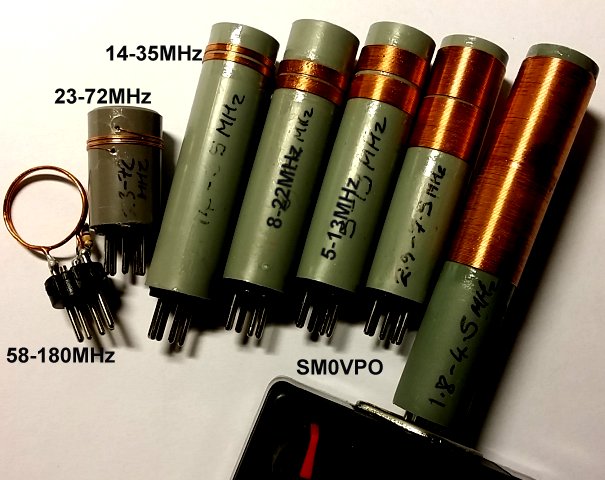

The scale is 50mm diameter. One lesson I learned from the old GDO project is that after about 10 years of use the dial became difficult to read due to smudging and dirty finger marks. So I recommend that you use a circular cursor that covers the whole dial. You can visit your local Lions shop, car-boot sale, or Red-Cross shop and buy an old cassette (please choose any rap or Barry Manilow cassette). The plastic case is perfect to cut out a cursor, and the Barry Manilow tape you should throw away. You can fit a temporary thin-strip cursor for calibration so that you can write on the dial. I then recommend you scan the dial, use Photo-Shop and create a new dial using the calibration marks from the scanned document. The result will look a lot more professional.
Sweep the dial from end-to-end and measure the frequency. Note that there must be no metal objects close to the coil during calibration. Mark the dial with key frequencies. If you are a radio amateur then you may want to prioritise the HF bands, then scan it when you have calibrated. Do NOT select "rescale" or the pixel resolution will get worse, just like a Micro$oft icon - choose "print size" and it will keep the same pixel resolution.
The actual calibration to identify frequencies can be done in a variety of ways. One really crude way is to use an FM radio with no antenna, then find the harmonics. If you find a harmonic at 90MHz and the next one at 108 then the GDO is oscillating at about 18MHz. When the original GDO was built it was a real pain in the arse to calibrate, but today there are SDR receivers, RaspberryPI spectrum analysers, and all manner of frequency counters, and even a little frequency counter using a PIC processor. I shall hopefully post my PIC frequency counter on www.sm0vpo.com shortly, complete with SW, PCBs and photographs. The project is quite simple. The SW uses routines based on other designs, but it is just a 5-digit frequency counter. I did not program any frequency offsets, IF shift, USB/LSB shift, RIT, overhead-underhang or any of the "bells and whistles" budding young programmers seem to love spending hours to code. My frequency counter only counts frequencies, and from 10kHz to 50MHz.

In the picture of the (almost) completed GDO below, you will notice that there is only one coil provisionally calibrated, and the dial cursor has not (yet) been fitted. This I will finish later, but "lash-up" (temporary) coils show that the GDO works well from 200kHz and up to 200MHz. It works well with all the coils from my old GDO, although they have a smaller coil diameter. If I have the time then I will update this project with the rest of the coils, but for the moment you have a working project, loosely based on my previous project.
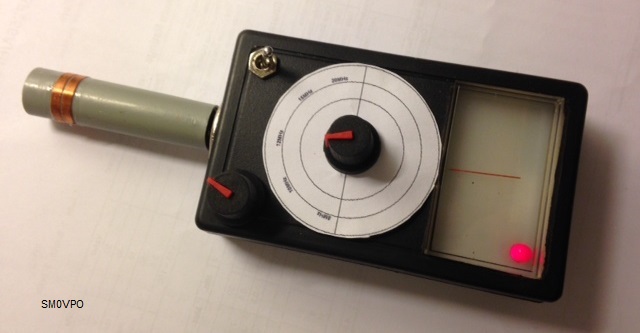
It took a lot of effort to build this project since I do not now have any proper workshop facilities. I did not use a saw to cut anything so that there was the minimum mess in the sitting room. The box was repeatedly scored with a Stanley knife to make the hole for the meter. I only had to use a drill for the round holes, but do not let Maj-Lis know I was drilling in the sitting room. The project looks good, at least, it will when the finishing touches are complete.
The project draws only 3.5mA, so the batteries should last for years with normal use. I may look into the possibility of putting a white LED behind the dial and put that in series with the red LED. It will not take any more current, but it may make the GDO a bit more sensitive to battery voltage. We will see.
Finally, I know that several of you have reacted to my old GDO project and the terminology I use. Grid-Dip Oscillator is the original term used for this instrument when it was created using vacuum valves (tubes), and I don't intend to call it a Drain-Dip Oscillator. I mean, "Floppy Disks" were floppy in the 5.25" format. 3.5" floppies were quite stiff disks, but they never changed the name to "Stiff-Disk Drive (SDD)", did they? When photography started using several sequential pictures, they called the pictures "Movies", and when sound was added they updated them to "Talkies". Today we have reverted back to "Movies" (or "films", even though they are no-longer developed on a kilometre-long strip of celluloid film ;-).

With this project I have achieved all my goals and I feel more confident to give demonstrations to 60 people with this better-looking instrument. I am also a little surprised that I was able to get it into a box so small. Everything is shrunk to the limits of practicality, and still the huge meter looks good on the 6-metre projector screen.
I hope that this GDO will last me another 35 years, or more to the point, now that I am 65-years old I hope that I will last another 35 years to use it ;-) But 35 years from now I may not be so good at climbing trees to prune my HF antennas, so I may be asking one of you to help me with that.
This GDO is simple, easy to make, and I built this one in just one weekend in the sitting-room, including gathering all the bits I needed. The total building cost is around (prices in Swedish kronor; SEK):
| Major item needed | Price (SEK) |
|---|---|
| Plastic box | SEK 35.00 |
| Tuning capacitor | SEK 16.00 |
| Plug/socket | SEK 12.00 |
| Single-pole 2-way (+ centre OFF) toggle switch | SEK 12.00 |
| Meter 100μA (50μA to 500μA) | SEK 0.00 |
| Grand total | SEK 75 (US$10) |
I must also add that the GDO is perhaps the most useful instrument I have ever owned, and it has been the major instrument in my homebrew experiments for the past 50 years. My first GDO used a 6J5 triode (RCA, octal base, in a metal envelope). I place the GDO before the oscilloscope and spectrum analyser, and in that order.

I hope that you enjoy this project and if you are an avid radio constructor then you may find this project very useful for pruning antennas, cutting coaxial baluns, multiband antenna traps, making coils for receivers & transmitters, as a quick'n-dirty signal generator, even measuring the lengths of long wires or impressing 60 people at a time when delivering a course.
Dont forget to visit my messageboard if you have any questions about this or any other project. I always look forward to receiving feedback, positive or negative. You do not have to register to post messages.
Very best regards from Harry Lythall
SM0VPO (QRA = JO89WO), Märsta, Sweden.
EA/SM0VPO (QRA = IM86BS), Nerja, Spain.